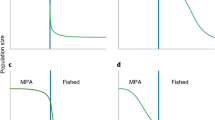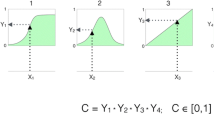Abstract
Marine protected areas (MPAs) are increasingly being recognized as an alternative management tool for conserving marine resources and ecosystems. By integrating organism dispersal rates, ecosystem interactions and fishing effort dynamics, ECOSPACE, a spatially explicit ecosystem-based modeling tool, allowed us to compare the ecological consequences of alternative MPA zoning policies within the proposed Gwaii Haanas National Marine Conservation Area, located off the west coast of British Columbia, Canada. The desired effects of MPAs include higher fishery yields, the conservation of biodiversity, and/or the preservation of intact ecosystems. However, ECOSPACE predicts that when MPAs are small, species interactions and movements may make these objectives difficult to achieve. ECOSPACE suggests that the effects of MPAs are reduced at their boundaries where fishing effort is predicted to concentrate. Furthermore, top predators may become more abundant within MPAs, which could lead to a depression of their prey species and a subsequent increase of species at even lower trophic levels. Trophic cascade patterns and density gradients across boundaries are nontrivial departures from our simple expectations of how MPAs protect areas and will force us to reconsider what constitutes effective conservation. Our ECOSPACE model indicates that the establishment of multi-use buffer zones may help alleviate these realistic but worrisome ecological predictions. When coupled with an overall reduction in harvest pressure, ECOSPACE suggests that a MPA with a large core `no-take' zone and large buffer will result in the greatest increase in organism biomass. The use of marine zoning may be an effective management tactic to reduce social conflict and conserve marine ecosystems.
Similar content being viewed by others
References
Allison GW, Lubchenco J and Carr MH ( 1998) Marine reserves are necessary but not sufficient for marine conservation. Ecol Appl 8: S79–92
Alcala AC (1988) Effects of marine reserves on coral fish abundances and yields of Philippine coral reefs. Ambio 17: 194–199
Alcala AC and Russ GR (1990) A direct test of the effects of protective management on abundance and yield of tropical marine resources. J Cons Cons Int Explor Mer 46: 40–47
Attwood CG and Bennett BA (1994) Variation in dispersal of Galjoen (Coracinus capensis) (Teleostei: Coracinidae) from a marine reserve. Can J Fish Aquat Sci 51: 1247–1257
Babcock RC, Kelly S, Shears NT, Walker JW and Willis TJ (1999) Changes in community structure in temperate marine reserves. Mar Ecol Prog Ser 189: 125–134
Beattie A (1999) The hecate strait model. In: Haggan N and Beattie AI (eds.), Back to the Future: Reconstructing the Hecate Strait Ecosystem. Fisheries Centre Research Report Vol. 7(3). University of British Columbia, Vancouver, BC
Bennett BA and Atwood CG (1991) Evidence for recovery of a surfzone fish assemblage following the establishment of a marine reserve on the southern coast of South Africa. Mar Ecol Prog Ser 75: 173–181
Bohnsack JA (1996) Marine reserves, zoning, and the future of fishery management. Fisheries 21: 14–16
Botsford LW, Castilla JC and Peterson CH (1997) The management of fisheries and marine ecosystems. Science 277: 509–515
Canada (1993) Gwaii Haanas Agreement Between the Government of Canada and the Council for the Haida Nations. Environment Canada, Ottawa, Ontario
Canadian Charter of Rights and Freedoms, Part I of the Constitution Act, 1982, being Schedule B to the Canada Act 1982 (U.K.), 1982, c.11.
Carr MH and Reed DC (1993) Conceptual issues relevant to marine harvest refuges: examples from temperate reef fisheries. Can J Fish Aquat Sci 50: 2019–2028
Castilla JC and Durán LR (1985) Human exclusion from the rocky intertidal zone of central Chile: the effects on Concholepas concholepas (Gastropoda). Oikos 45: 391–399
Christensen V and Pauly D (1992) ECOPATH II-a software for balancing steady-state models and calculating network characteristics. Ecol Model 61: 169–185
Cole RG and Keuskamp D (1998) Indirect effects of protection from exploitation: patterns from populations of Evechinus chloroticus (Echinoidea) in northeastern New Zealand. Mar Ecol Prog Ser 173: 215–226
Delgamuukw v. British Columbia. (1997) Supreme Court of Canada. S.C.R. 1010
Dugan JE and Davis GE (1993) Applications of marine refugia to coastal fisheries management. Can J Fish Aquat Sci 50: 2029–2042
Estes JA and Carr M (1999) Planning for the conservation and management of coastal marine resources in British Columbia. Workshop Proceedings: Central Coast Land and Resource Management Process, Vancouver, BC
Guénette S, Lauck T and Clark C (1998) Marine reserves: from Beverton and Holt to the present. Rev Fish Biol Fish 8: 251–272
Harper JR (1995) Part 5: Implementation of National Marine Conservation Area (NMCA) strategy for Gwaii Haanas; Preliminary concepts. Proceedings of the National Marine Conservation Areas Workshop
Hastings A and Botsford LW (1999) Equivalence in yield from marine reserves and traditional fisheries management. Science 284: 1537–1538
Hilborn R and Walters CJ (1987) A general model for simulation of stock and fleet dynamics in spatially heterogeneous environments. Can J Fish Aquat Sci 44: 1366–1369
Kramer DL and Chapman MR (1999) Implications of fish home range size and relocation for marine reserve function. Environ Biol Fishes 55: 65–79
Mercier F and Mondor C (1995) Sea to Sea to Sea, Canada's National Marine Conservation System Plan. Parks Canada, Department of Canadian Heritage, Ministry of Supply and Services Canada, Ottawa, Ontario
National Research Council (1995) Understanding marine biodiversity: A research agenda for the nation. National Academy Press, Washington, DC
Okey TA and Pauly D (eds.) (1998) A TrophicMass-Balance Model of Alaska's Prince William Sound Ecosystem, for the Post-Spill Period 1994–1996. Fisheries Centre Research Report, Vol. 6 (4). University of British Columbia, Vancouver, BC
Palsson W A and Pacunski RE (1995) The response of rocky reef fishes to harvest refugia in Puget Sound. In: Puget Sound Research, Vol. 1. Puget Sound Water Quality Authority, Olympia, WA
Parks Canada (1994) Parks Canada Guiding Principles and Operational Policies: National Marine Conservation Areas Policy. Ministry of Supply and Services Canada, Ottawa, Ontario
Pauly D, Christensen V, Dalsgaard J, Froese R and Torres F Jr. (1998) Fishing down marine food webs. Science 279: 860–863
Persky S (1998) Delgamuukw; The Supreme Court of Canada Decision on Aboriginal Title. Grey Stone Hooks, Vancouver, BC
Polovina JJ (1984) Model of a coral reef ecosystem I. The ECOPATH model and its application to French Frigate Shoals. Coral Reefs 3: 1–11
Polunin NVC and Roberts CM (1993) Greater biomass and value of target coral-reef fishes in two small Caribbean marine reserves. Mar Ecol Prog Ser 100: 167–176
Ruesink JL (1998) On ecosystem models as caricatures. In: Okey TA and Pauly D (eds.), A Trophic Mass-Balance Model of Alaska's Prince William Sound Ecosystem, for the Post-Spill Period 1994–1996. Fisheries Centre Research Report, Vol. 6 (4). University of British Columbia, Vancouver, BC
Roberts CM (1997a) Ecological advice for the global fisheries crisis. Trends Ecol Evol 12: 35–38
Roberts CM (1997b) Connectivity and management of Caribbean coral reefs. Science 278: 1454–1457
Sobel J (1996) Marine reserves: Necessary tools for biodiversity conservation? Global Biodiversity 6: 8–18
Wallace SS (1999) Evaluating the effects of three forms of marine reserve on northern abalone populations in British Columbia, Canada. Cons Biol 13: 882–887
Walters C (1986) Adaptive Management of Renewable Resources. Macmillan Publishing Company, New York
Walters C (1998) ECOSIM and ECOSPACE: basic considerations. In: Pauly D (ed.) Use of ECOPATH with ECOSIM to Evaluate Strategies for Sustainable Exploitation of Multi-Species Resources. Fisheries Centre Research Reports, Vol. 6 (2). University of British Columbia, Vancouver, BC
Walters C (2000) Impacts of dispersal, ecological interactions, and fishing effort dynamics on efficacy of marine protected areas: how large should protected areas be? Bull Mar Sci 66: 745–757
Walters C, Christensen V, Pauly D (1997) Structuring dynamic models of exploited ecosystems from trophic mass-balance assessments. Rev Fish Biol Fish 7: 1–34
Walters C, Pauly D and Christensen V (1999) ECOSPACE: prediction of mesoscale spatial patterns in trophic relationships of exploited ecosystems, with emphasis on the impacts of marine protected areas. Ecosystems 2: 539–554
Zeller DC and Russ GR (1998) Marine reserves: patterns of adult movement of the coral trout (Plectropomus leopardus (Serranidae)). Can J Fish Aquat Sci 55: 917–924
Rights and permissions
About this article
Cite this article
Salomon, A.K., Waller, N.P., McIlhagga, C. et al. Modeling the trophic effects of marine protected area zoning policies: A case study. Aquatic Ecology 36, 85–95 (2002). https://doi.org/10.1023/A:1013346622536
Issue Date:
DOI: https://doi.org/10.1023/A:1013346622536




